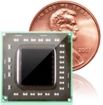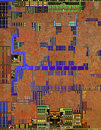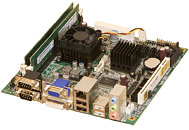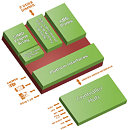- Joined
- Oct 9, 2007
- Messages
- 47,808 (7.40/day)
- Location
- Dublin, Ireland
| System Name | RBMK-1000 |
|---|---|
| Processor | AMD Ryzen 7 5700G |
| Motherboard | Gigabyte B550 AORUS Elite V2 |
| Cooling | DeepCool Gammax L240 V2 |
| Memory | 2x 16GB DDR4-3200 |
| Video Card(s) | Galax RTX 4070 Ti EX |
| Storage | Samsung 990 1TB |
| Display(s) | BenQ 1440p 60 Hz 27-inch |
| Case | Corsair Carbide 100R |
| Audio Device(s) | ASUS SupremeFX S1220A |
| Power Supply | Cooler Master MWE Gold 650W |
| Mouse | ASUS ROG Strix Impact |
| Keyboard | Gamdias Hermes E2 |
| Software | Windows 11 Pro |
AMD today announced immediate availability of the new AMD Embedded G-Series processor, the world's first and only Accelerated Processing Unit (APU) for embedded systems. The AMD Embedded G-Series, based on AMD Fusion technology, delivers a complete, full-featured embedded platform and incorporates the new low-power, x86 CPU based on the "Bobcat" core with a world-class DirectX 11-capable GPU and parallel processing engine on a single piece of silicon.
"AMD's commitment is to ensure the game-changing technologies we develop for consumers and the enterprise are also available for the vast and growing embedded market," said Patrick Patla, corporate vice president and general manager, Server and Embedded Division, AMD. "Today, we have a record number of embedded launch partners. They are using the unique advancements of the AMD Embedded G-Series APU to develop a brand new generation of highly differentiated, energy-efficient, small form-factor embedded systems that can deliver the vivid visual experience expected in our always-connected world."




Design and Development Support
View at TechPowerUp Main Site
"AMD's commitment is to ensure the game-changing technologies we develop for consumers and the enterprise are also available for the vast and growing embedded market," said Patrick Patla, corporate vice president and general manager, Server and Embedded Division, AMD. "Today, we have a record number of embedded launch partners. They are using the unique advancements of the AMD Embedded G-Series APU to develop a brand new generation of highly differentiated, energy-efficient, small form-factor embedded systems that can deliver the vivid visual experience expected in our always-connected world."



- This new class of accelerated processor combines more compute capabilities on a single die than any processor in the history of computing and represents opportunity for major advancements in embedded systems.
- No solution with this level of advanced computing is available for the embedded market today.
- Numerous embedded systems based on the AMD Embedded G-Series are available today or expected to launch in the coming weeks from companies including Advansus, Compulab, Congatec, Fujitsu, Haier, iEi, Kontron, Mitec, Quixant, Sintrones, Starnet, WebDT, Wyse, and many others.
- Expected products include graphics-intensive solutions like digital signage, internet-ready set top boxes, mobile and desktop thin clients, casino gaming machines, point-of-sale kiosks, and small form factor PCs, as well as numerous single board computers (SBCs).
- Shane Rau, research director of Computing and Storage Semiconductors at IDC, expects shipments of processors for embedded systems to increase at a double digit rate each year for the next five years.
- This brand new platform continues AMD's mission to lower power, shrink physical component area, and reduce the costs of designing and producing x86 embedded systems.

Design and Development Support
- The open development ecosystem for the AMD Embedded G-Series platform includes multiple BIOS options, support for various Microsoft Windows, Linux, and real-time operating systems, the integrated OpenCL programming environment, and source-level debug tools.
- AMD provides a dedicated design support team to help customers create distinctive new products and bring them to market quickly.
- Online resources include an embedded developer portal, AMD embedded product selection guide and customer-submitted details on available boards and complete systems.
- 1 or 2 x86 "Bobcat" CPU cores with 1MB L2 cache, 64-bit Floating Point Unit
- Up to 1.6 GHz
- 9W and 18W TDP
- Array of SIMD Engines
- DirectX(R) 11 capable graphics
- Industry-leading 3D and graphics processing
- 3rd Generation Unified Video Decoder
- Power management features, including C6 and power gating
- DDR3 800-1066 memory with support for 64 bit channel and 2 DIMMs
- Ball Grid Array (BGA) package
- 890mm physical footprint, including the AMD Fusion I/O Controller Hub
View at TechPowerUp Main Site







 I desperately wanted an AMD netbook or 11~12" laptop, but nothing had the battery life I wanted and ran too hot. Once fusion gets into netbooks or ultra-portables, I'm jumping on them for sure.
I desperately wanted an AMD netbook or 11~12" laptop, but nothing had the battery life I wanted and ran too hot. Once fusion gets into netbooks or ultra-portables, I'm jumping on them for sure.